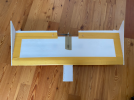All of the webpages I had that provided the various calculators to aid in RC airplane design like wing loading an others have since gone away and are no longer available. I suspect some google fu ( web searching ) may provide others that are suitable for that. So I'll just address this generically and then give an opinion... well, much of this is opinion until tested... but a lot will be based on comparisons to other flying wing aircraft.
Your AUW is high for a flying wing of this size. The motor, despite not providing all of the motor specs one would really need... is much larger than what I see on similar sized aircraft. So the power to weight is probably way overkill... but the wing loading appears is too high ( too heavy ) for the size of the wings. How much the oversized motor will affect the flight performance will be determined by where the CG is on the wing in relation to where the motor is mounted.
Here is a typical flying wing plans and recommended equipment well suited for beginner builders ( notice I didn't say beginning flyer )... see
Flying Wing RC plane foam free plans for beginners
The above is just one flying wing from a web search... I welcome you to do others to see even more comparisons. When designing an aircraft, this is one of the places I start, I do a web search for a comparable aircraft and use the specs they list to base a design on. Building it first and then checking is the proverbial "putting the cart before the horse".
A RC flying wing would be classified in the stunt / combat category of RC airplanes. They are typically easy to build and are usually tough if properly designed so can survive some rough landings easier because of their simple construction. These are not what I'd call a good beginners airplane. They lack the stability most new pilots will need and because of their design, don't provide any visual clues as to their orientation when in the air. When an airplane is in a bright sky, they all are often silhouetted against the sky so no amount of design or color schemes can compensate for that fact. With that said, it requires a pilot that has already learned about aircraft orientation more than a beginner has learned.
As an untested design, you would be best to get the help of a pilot that is used to test flying. Their experience can often mean the difference between a successful flight and ending up with a "pile of sticks" ( reference to balsa airplanes but still fits here ). Every pilot we had at our RC club would look over a plane before accepting if they would test fly it first... then if they did, even with the experience they had... would likely be gritting their teeth during the maiden flights. If you are a beginner or even a not well seasoned pilot, test flying an unproven design is a mistake.
